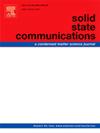Thiosulfate ion degradation on gold (111) surface: A DFT study
IF 2.4
4区 物理与天体物理
Q3 PHYSICS, CONDENSED MATTER
引用次数: 0
Abstract
We have investigated the interaction of thiosulfate ion (S2O32−) on gold (111) surface as an alternative to cyanide in gold leaching by the density functional theory (DFT) method. The results show that this interaction leads to the degradation of thiosulfate ion on the gold (111) surface. Thiosulfate ion degradation happened through S-S bond breaking and led to formation of an adsorbed sulfur specie and a released SO3 molecule (inter-bond angle of 120° and a bond length of 1.43 Å). Furthermore, the adsorbed sulfur specie was adsorbed at the hollow site on the gold (111) surface and bonded to three surface Au atoms (bond lengths: 2.33 Å). This interaction led to a rearrangement of the upper Au layer. To describe the nature of adsorbed sulfur specie, we have investigated the interaction of elemental sulfur (S0) and sulfide ion (S2−) on the gold (111) surface. The interaction of elemental sulfur and the gold (111) surface has a more similar geometry to sulfur specie product of thiosulfate ion degradation on the gold (111) surface. Also, by increasing the charge of system, the S-three Au atoms bond lengths has increased. It shows that by increasing the charge of system, the tendency of sulfur specie to the gold (111) surface has decreased. Based on the results, the rearrangement of the upper Au layer isn't because of the interaction of the thiosulfate ion. This phenomenon is because of the interaction of the sulfur specie as a thiosulfate degradation product (adsorbed sulfur) on the gold (111) surface.
硫代硫酸盐离子在金(111)表面降解的DFT研究
采用密度泛函理论(DFT)方法研究了硫代硫酸盐离子(S2O32−)在金(111)表面作为氰化物的替代物的相互作用。结果表明,这种相互作用导致硫代硫酸盐离子在金(111)表面的降解。硫代硫酸盐离子通过S-S键断裂降解,形成吸附的硫种和释放的SO3分子(键间角为120°,键长为1.43 Å)。此外,所吸附的硫元素被吸附在金(111)表面的空心位置,并与三个表面Au原子键合(键长:2.33 Å)。这种相互作用导致了上层金层的重排。为了描述吸附硫的性质,我们研究了单质硫(S0)和硫离子(S2−)在金(111)表面的相互作用。单质硫与金(111)表面的相互作用具有与硫代硫酸盐离子在金(111)表面降解的硫种产物更相似的几何形状。同时,随着系统电荷的增加,s - 3 Au原子的键长增加。结果表明,随着系统电荷的增加,硫化物向金(111)表面的倾向减弱。结果表明,上金层的重排不是硫代硫酸盐离子相互作用的结果。这种现象是由于硫种作为硫代硫酸盐降解产物(吸附硫)在金(111)表面的相互作用。
本文章由计算机程序翻译,如有差异,请以英文原文为准。
求助全文
约1分钟内获得全文
求助全文
来源期刊

Solid State Communications
物理-物理:凝聚态物理
CiteScore
3.40
自引率
4.80%
发文量
287
审稿时长
51 days
期刊介绍:
Solid State Communications is an international medium for the publication of short communications and original research articles on significant developments in condensed matter science, giving scientists immediate access to important, recently completed work. The journal publishes original experimental and theoretical research on the physical and chemical properties of solids and other condensed systems and also on their preparation. The submission of manuscripts reporting research on the basic physics of materials science and devices, as well as of state-of-the-art microstructures and nanostructures, is encouraged.
A coherent quantitative treatment emphasizing new physics is expected rather than a simple accumulation of experimental data. Consistent with these aims, the short communications should be kept concise and short, usually not longer than six printed pages. The number of figures and tables should also be kept to a minimum. Solid State Communications now also welcomes original research articles without length restrictions.
The Fast-Track section of Solid State Communications is the venue for very rapid publication of short communications on significant developments in condensed matter science. The goal is to offer the broad condensed matter community quick and immediate access to publish recently completed papers in research areas that are rapidly evolving and in which there are developments with great potential impact.
 求助内容:
求助内容: 应助结果提醒方式:
应助结果提醒方式:


